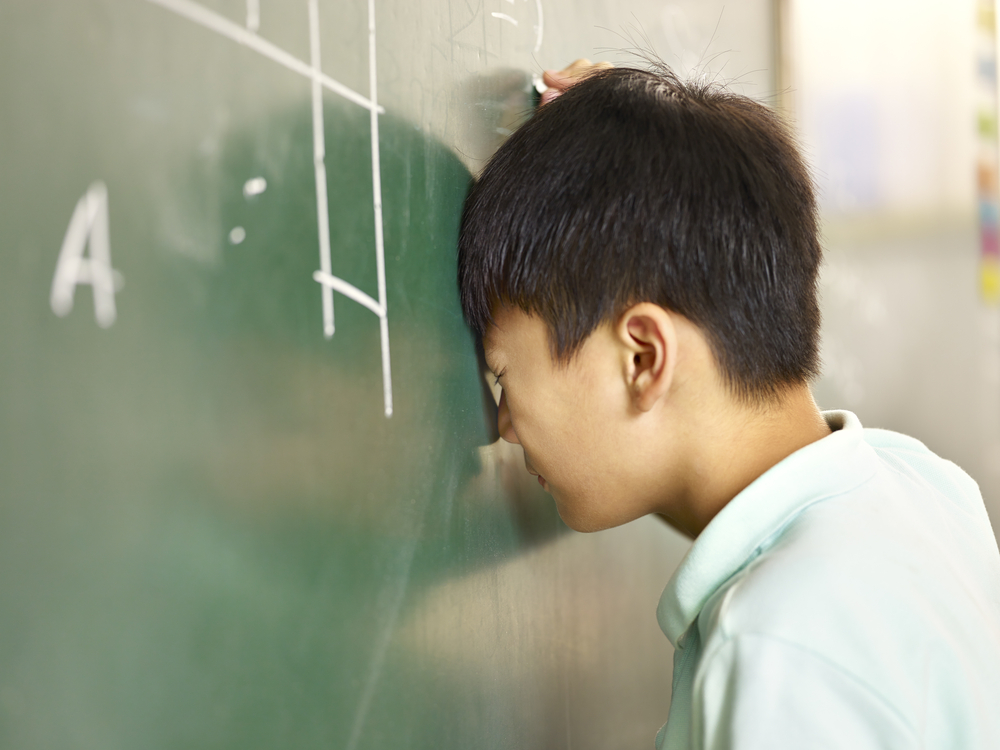What is head banging in autism?
Head banging is a form of repetitive, self-harming behavior that’s often seen in adults or children with autism spectrum disorder (ASD). From the outside, it can be incredibly unsettling to witness, particularly for parents and caregivers. But what’s important to understand about this behavior is that, instead of it being a sign of aggression or “bad behavior,” head banging in autism often serves a purpose.
Sure, occasional head-banging, especially in toddlers, can be considered normal; it tends to peak at 18 months and resolves itself around three years old, as children develop language and coping skills. However, in children with autism, head banging can last a lot longer, occur a lot more often, and ultimately, it can serve a different purpose related to communication difficulties, sensory processing, and emotional regulation, all when other coping mechanisms are not available. The faster parents and caregivers are at understanding the causes of the head banging, the better able they’ll be to provide practical support to reduce its potential harm.
What causes head banging in autism?
Head banging in autism can be linked to a variety of different factors, including the following.
Difficulties with emotional regulation
One of the most common causes of head banging in autism is difficulty with emotional regulation. Many adults and children find it extremely difficult to manage the intense feelings of anxiety, fear, frustration, and any type of overstimulation in autism. These challenges are closely tied to autism and emotional regulation, where individuals may lack effective coping strategies or the ability to communicate their feelings. As a result, they may resort to head-banging as a way to self-soothe or release emotional tension. Within this context, head-banging isn’t seen as an act of aggression but rather an attempt to regain control in moments of emotional overload.
Medical or physical discomfort
There are certain situations where undiagnosed physical pain or a medical issue triggers self-injurious behavior in a person on the spectrum. Autistic individuals have historically had difficulty with communication and, therefore, are often unable to articulate what hurts and where. Instead, they may engage in head banging as a way to signal distress. Whether it’s a headache, an ear infection, gastrointestinal issues, or other sources of discomfort, if the autistic person is unable to communicate their pain, sometimes their only means of expression is head banging. Parents and caregivers should take particular notice of it if the behavior is new, frequent, or occurring at the same time as other physical symptoms.
Environmental Triggers
When there are changes in a person’s routine, transitions between activities, or overstimulating environments, these situations can lead to head banging in autism. Many individuals on the spectrum work best when their routine is structured and their lifestyle is predictable. In the event there is any disruption to the routine, this can trigger head banging as a reaction to the feeling of being out of control or unsafe. Other environmental triggers may include sensory overload (e.g., loud noises, bright lights), unfamiliar places, or a sudden change in plans.
Head Banging in Autism as Communication vs. Self-Harm
Head banging in autism is often misinterpreted as a deliberate act of self-harm. Still, for many individuals on the spectrum, it’s a method of communication, particularly when they’re unable to use conventional language. Due to autism and communication difficulties, many autistic children and adults are unable to express their needs, wants, or discomfort using words. In these situations, head banging becomes an autistic non-verbal response to communicate distress or indicate that something isn’t right. Rather than viewing the behavior as “bad” or intentionally harmful, it’s essential to recognize it as a meaningful expression that requires attention and resolution.
Physical Consequences
While not always intentional, head banging in autism can still lead to serious self-harm. In mild cases, head banging may cause bruising, cuts, and swelling to the area because of the repetitive movements. But in more severe cases, head banging can result in long-term physical damage, including fractures, concussions, and even brain damage. It’s for these reasons that it is crucial to address this behavior quickly to prevent further harm and ensure the person’s physical safety.
Emotional and behavioral concerns
Head banging in autism can also cause tremendous emotional and behavioral concerns. Witnessing this behavior can often stir feelings of helplessness, fear, frustration, and sadness. Caregivers may struggle with emotional burnout, while other children in the household may feel overwhelmed and confused. This ongoing stress highlights the importance of professional support and intervention, not only to reduce the behavior but also to protect the emotional health of everyone involved.
Understanding the emotional toll these challenges can take means it’s equally important to hear from families who’ve found support. The following testimonial from one of our Heartlinks parents offers a firsthand view of the progress that’s possible with consistent and compassionate therapy.
“My daughter has been receiving services for two years, and I am EXTREMELY grateful for the dedication they give in providing quality care for my child. My daughter began with minimal social skills and a lack of confidence to be able to express herself with confidence, and has built up her social skills tremendously. I have recommended Heartlinks to a coworker and will continue to recommend it to anyone who needs services. For anyone reading this, please trust that you will receive the best quality of care. You can thank me later.” D. Thomas, Real Heartlinks Parent.
Sensory processing issues in head-banging and autism
Sensory processing differences are another common factor underlying head banging in autism. In comparison to their neurotypical peers, many adults and children on the spectrum experience the world in ways that are either heightened or dulled. The everyday sensations of light, sound, textures, and movement can and do become overwhelming or are barely noticed at all. These sensory extremes are significant to consider in people with autism and communication difficulties, who may not be able to verbalize their experiences or needs. In fact, these sensory patterns often overlap with high-functioning autism symptoms, where individuals may appear outwardly “normal” but still encounter intense struggles around sensory input and regulation.
How head banging is a form of sensory processing differences.
In certain situations, head banging may occur as a response to sensory overload as a physical outlet to manage overwhelming input. Autistic sensory seeking is often used as a way to generate sensory input that a person on the spectrum can use to feel comfort or more grounded in a situation. This is particularly relevant in cases of understimulated autism, where the brain is not receiving enough input from the environment. When this happens, the individual on the spectrum self-generates stimulation through repetitive behaviors such as head banging. Regardless of whether the behavior is triggered by overload or understimulation, recognizing these sensory-driven motivations allows for more compassionate and effective interventions.
Interventions for managing head banging and autism safely
Managing head banging in autism begins with identifying the root cause. From sensory needs and communication barriers to behavioral patterns, undergoing a behavioral assessment administered by a trained professional can help uncover the triggers and underlying causes of the behavior.
Once that is complete, the next step is to make environmental changes, including reducing noise, adjusting lighting, or creating predictable routines. All of these steps can help prevent triggers. For those demonstrating stimming behaviors, providing sensory tools and supports (i.e., fidget toys) can offer healthier alternatives.
For those on the spectrum who have difficulty with communication, equipping them with alternative communication devices such as PECS (picture exchange communication systems) or speech devices is also equally important. When safe and effective coping tools are used, head banging can be reduced, and more constructive behaviors can emerge.
The role of ABA therapy as a professional intervention
Managing head banging in autism often requires a comprehensive approach. One of the most effective methods is Applied Behavior Analysis (ABA) therapy. Therapists have at their disposal a variety of techniques, like ABA, positive reinforcement, and replacement strategies, to reduce harmful behaviors and teach safer ways to communicate. A frequent focus within most ABA therapy programs is behavior reduction ABA, which is designed to decrease self-injurious actions like head banging by understanding what is their purpose and then introducing more adaptive behaviors. Other options include ABA in-home therapy for consistent support in the familiar home environment.
In addition to or in conjunction with ABA, occupational therapy can help with an autistic person’s sensory difficulties by introducing tools and strategies to help regulate autistic sensory seeking behaviors. Speech therapy is another good approach, particularly for those on the spectrum with communication difficulties. In combination, these therapies provide a well-rounded plan to reduce head banging and support long-term growth.

Consult with ABA Therapy Experts in your Area Today: Georgia, Indiana, New Jersey, and North Carolina
If your child is showing signs of head banging in autism or other challenging behaviors, early support can make a tremendous difference. Heartlinks ABA is proud to serve families across the following states:
We offer personalized, compassionate care that is founded in evidence-based practices. Whether you’re just beginning your journey and learning about the different therapy options available to your child, or you’re looking to expand their current support team, our certified therapists can help.
Contact Heartlinks ABA for a free consultation
Take the first step toward safer, more effective behavior strategies. Reach out to Heartlinks ABA for a free consultation.
FAQs
- Will my child outgrow head banging?
The answer is, it depends. Some children do outgrow head banging, particularly if it’s connected to sensory exploration or limited communication (before therapy). But it may persist without intervention and often needs the support of a trained BCBA therapist to reduce or replace the behavior.
- Does head banging mean my child is in pain?
Not always, but it can. There will be situations where head banging is a way to express feelings of discomfort, such as an ear infection or a stomachache. This is particularly true if your child has limited communication abilities.
- At what age is head banging in autism concerning?
Though head banging is more common in toddlers, if it continues past the age of 3 or increases in intensity or frequency, this may signal underlying sensory seeking behaviors or emotional and/or communication challenges that require evaluation.
- Is head banging a sign of ADHD?
Head banging is not a core symptom of ADHD. Yet children with ADHD may exhibit impulsive or self-stimulating behaviors like head banging or ADHD hand flapping. Of note is that persistent head banging is more often linked to sensory or communication needs, particularly in autism.
- Is head banging a sign of autism?
It certainly can be a sign. While on its own, head banging doesn’t confirm autism, it is considered a potential indication, particularly if the child is also demonstrating communication difficulties, repetitive behaviors, or other social delays.
